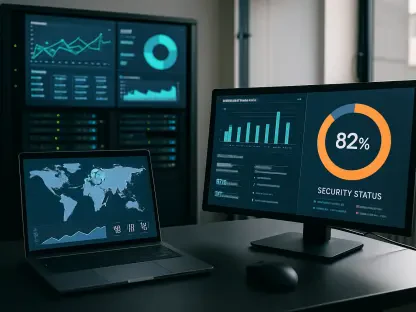The growing prevalence of cloud computing has revolutionized the way businesses operate, offering unparalleled scalability, flexibility, and data accessibility. However, these benefits come with heightened vulnerability to cyber threats. In this context, Artificial Intelligence (AI) and Machine Learning (ML) emerge as pivotal technologies to fortify cloud security. By leveraging their capabilities, organizations can address the dynamic and sophisticated nature of modern cyber threats.
Real-Time Threat Detection and Automated Response
Speed and Efficiency of AI and ML
AI and ML possess an unmatched ability to process and analyze vast datasets at remarkable speeds. In cloud environments, where data flows continuously from diverse sources, this capability is crucial. The technologies scan for potential security threats, anomalies, and patterns in real time, ensuring that vulnerabilities are identified almost instantaneously.
The speed at which AI and ML operate is a game-changer in cloud security. Traditional manual methods of threat detection and response are often too slow to keep up with the rapid pace of cyber-attacks. These human-dependent measures cannot match the quick, efficient analysis and decision-making capabilities of AI and ML. Cloud environments, characterized by their large, dynamic data sets, have a greater need for real-time analytics to prevent breaches effectively. AI and ML’s proficiency in processing and analyzing vast quantities of information allows them to detect subtle patterns and anomalies that might indicate a security threat, providing a significant edge in the race against cyber threats.
Automated Threat Neutralization
One of the most significant advantages of integrating AI and ML into cloud security is the automation of threat detection and response. These technologies can autonomously identify security incidents and initiate countermeasures without human intervention. This means that attacks can be neutralized before they escalate, safeguarding systems and data effectively and promptly.
The automation of threat neutralization enhances the efficiency of cloud security protocols. Security incidents, if left unchecked for even a short period, can result in substantial damage. The ability of AI and ML to act autonomously ensures a rapid response to threats, limiting potential damage and maintaining the integrity of the cloud environment. Autonomous systems can isolate affected areas, quarantine suspicious files, and implement necessary security protocols without waiting for human input. This level of automation not only speeds up the response time but also frees up human resources to focus on strategic security planning and threat prevention, further fortifying the cloud infrastructure.
Automating Security Processes and Reducing Workloads
Reducing Manual Oversight
By automating various cloud security processes, AI and ML significantly lessen the workload of security teams. Automated tools powered by AI can detect and correct misconfigurations or anomalies, ensuring consistent application of security protocols across cloud resources. This reduces the need for constant manual monitoring and intervention.
AI and ML relieve security professionals from the endless task of monitoring and managing cloud security manually. Human monitoring is not only time-consuming but also prone to errors, especially in a dynamic cloud environment where configurations can change frequently. The use of automated tools ensures that security measures are consistently applied, reducing the risk of human error. Furthermore, these tools can identify and rectify misconfigurations that might otherwise go unnoticed, thus closing potential security gaps and enhancing overall cloud security.
Cloud Security Posture Management (CSPM)
Cloud Security Posture Management (CSPM) tools epitomize the benefits of AI in maintaining an optimal security posture. These tools continuously monitor and assess cloud environments, identifying vulnerabilities and areas needing improvement. By employing such AI-powered solutions, organizations can enhance their cloud security with minimal manual effort.
CSPM tools provide a continuous, real-time assessment of cloud security, offering insights into the current security posture and highlighting areas that require attention. This proactive approach ensures that vulnerabilities are identified and addressed before they can be exploited by malicious actors. The ability of CSPM tools to provide a comprehensive view of the security landscape allows organizations to prioritize remediation efforts, ensuring that their resources are focused on the most critical areas. By leveraging AI, CSPM tools can adapt to the changing threat landscape, continuously improving and updating security protocols to protect against new and emerging threats.
Behavioral Analysis for Enhanced Detection
Establishing Baselines
Machine learning excels at studying and establishing baselines of typical user behavior. By understanding what constitutes “normal” activity, ML can readily identify deviations that may indicate unauthorized access or breaches. This is particularly effective for detecting insider threats, which are traditionally challenging to spot.
The ability to establish behavioral baselines is a significant advantage in the fight against cyber threats. By monitoring user activity over time, machine learning models can create a detailed profile of normal behavior patterns. When an activity deviates from this baseline, it triggers an alert, allowing security teams to investigate further. This approach is particularly effective in identifying insider threats, as it can detect subtle changes in behavior that may indicate malicious intent. Traditional security measures often overlook such threats, but ML’s ability to analyze and understand complex behavior patterns provides a crucial layer of protection.
Monitoring Internal Activities
Behavioral analysis through ML provides comprehensive security coverage by continuously monitoring both external and internal activities. This dual focus ensures that any anomalous behavior, whether from external attacks or internal compromise, is promptly identified and addressed, enhancing the overall security posture.
Continuous monitoring of internal activities ensures that any deviations from normal behavior are detected and addressed in real-time. This approach not only protects against external threats but also guards against the risk posed by insiders. Whether the threat comes from a malicious insider, a compromised account, or an external attacker, the ability to detect and respond to anomalies swiftly is crucial. ML’s continuous monitoring capabilities provide a comprehensive view of all activities within the cloud environment, ensuring that any suspicious behavior is promptly identified and mitigated.
Intelligent Prioritization and Automated Remediation
Focusing on Critical Threats
AI aids in evaluating security incidents based on their potential impact, severity, and contextual relevance. This prioritization allows security teams to allocate their resources effectively, focusing on addressing the most critical threats first.
The ability to prioritize threats is essential for effective cloud security. Not all threats are created equal, and some may pose a greater risk to the organization than others. AI’s ability to evaluate incidents based on various factors allows security teams to focus on the most critical threats first. This prioritization ensures that resources are allocated effectively, addressing the highest-priority issues promptly. By focusing on the most significant threats, security teams can reduce the risk of major incidents and ensure that their efforts are directed where they are most needed.
Automated Response Actions
Upon detecting a threat, AI can automate several response actions such as isolating affected systems, quarantining malware, and blocking suspicious IP addresses. These actions contain incidents swiftly, preventing further damage and ensuring that the cloud environment remains secure.
Automated response actions are a crucial component of an effective cloud security strategy. When a threat is detected, AI can take immediate action to contain the incident, preventing it from spreading and causing further damage. This rapid response is essential in minimizing the impact of security breaches. By automating response actions, organizations can ensure that threats are addressed promptly, without waiting for human intervention. This not only enhances the speed and efficiency of the response but also ensures that incidents are handled consistently and effectively.
Predictive Analysis and Improved Accuracy
Anticipating Future Threats
Predictive analysis is one of the key strengths of ML models. By leveraging historical data, ML can identify trends and anticipate future attack patterns. This proactive stance allows organizations to implement security measures ahead of time, significantly reducing the likelihood of successful attacks.
The ability to predict future threats is a significant advantage in maintaining cloud security. By analyzing historical data, machine learning models can identify patterns and trends that may indicate future attack vectors. This predictive capability allows organizations to take a proactive approach to security, implementing measures to protect against anticipated threats. By staying one step ahead of attackers, organizations can reduce the risk of successful attacks and ensure that their cloud environments remain secure.
Reducing False Positives and Negatives
The rise of cloud computing has fundamentally transformed business operations by providing unmatched scalability, flexibility, and access to data. Despite these significant advantages, the shift to cloud-based solutions also introduces increased risks from cyber threats. This is where Artificial Intelligence (AI) and Machine Learning (ML) step in as crucial technologies to enhance cloud security. By harnessing the advanced capabilities of AI and ML, companies can effectively tackle the ever-evolving and complex landscape of modern cyber threats.
AI and ML can detect anomalies and potential security breaches in real-time by examining vast amounts of data quickly and accurately. These technologies can identify patterns that might signify a cyber attack, offering preemptive measures to mitigate risks. Moreover, AI and ML algorithms can adapt to new threats, continuously learning and evolving to provide robust security defenses.
In addition to real-time threat detection, AI and ML can automate routine security tasks such as patch management, vulnerability assessment, and compliance checks. This automation not only improves efficiency but also frees up IT teams to focus on more strategic initiatives.
Overall, integrating AI and ML into cloud security protocols offers a proactive approach to safeguarding data and ensuring business continuity. As cyber threats grow in sophistication, leveraging these technologies becomes indispensable for any organization looking to protect its digital assets in the cloud.









